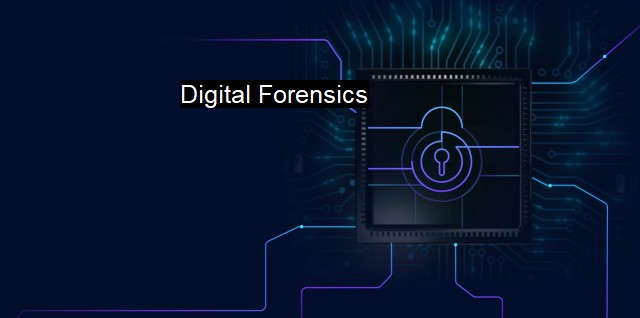What are Digital Forensics?
The Importance of Digital Forensic Strategy: Protecting Our Digital Assets
Digital forensics, a branch of cybersecurity, is an essential field of study and practice in the vast digital world where data is critical. It concerns the investigation, recovery, and interpretation of data found in digital devices, often used in both criminal and civil court cases. From law enforcement to corporate settings, digital forensic methods and tools are utilized to unravel digital data and gain valuable insights that can aid in various legal situations.Digital forensics helps unlock insights from digital data that are hidden or suppressed deliberately or automatically due to system operations influenced by various actions or applications such as viruses or software updates. It enables experts to delve into digital devices such as computers, smartphones, or any other data storage devices, to search out the digital footprints left behind by an illicit activity, often in the aftermath of cybercrimes and fraud.
At the heart of digital forensics is the concept of data preservation. Data recovered during a forensics investigation must be untouched and unchanged to ensure that it serves as credible evidence. A cybersecurity expert must verify that the recovered data remains as it was during the crime to prevent questions regarding data integrity, authenticity, and validity. Digital forensics tools combined with meticulous protocols ensure this preservation, providing a legal basis for the evidence.
Digital forensics serves as a complementary aspect, creating a defense mechanism and assisting in incident response. A deep understanding of a cyberattack or breach can help cybersecurity professionals develop methods to prevent future occurrences. The findings from a digital forensics investigation aid the overall cybersecurity strategy, providing an informed perspective on potential vulnerabilities and solutions.
Digital forensics plays a critical role in the combat against malicious software or malware, a significant threat in today's tech-driven landscape. Forensic investigators scrutinize malware to understand its behavior and origins, deciphering various facets such as attack vectors, exploitation techniques, and the kind of damage it can potentially cause.
In conjunction with antivirus software, digital forensics helps to expose system vulnerabilities that cybercriminals can exploit. The antivirus software provides a first line of defense and can sometimes detect the presence of malware in the system. Still, digital forensics goes beyond detection. It explores the nature of the attack, people involved, and even the potential purposes for which the malware was incorporated.
The correlation between digital forensics and antivirus software is fundamental in providing a comprehensive security framework. In a scenario where a company falls victim to a complex cyberattack, while the antivirus software focuses on bringing the situation under control by checking the spread of infection, the digital forensics team aids by figuring out the origin of the attack, the target data, and the plot behind the attack.
Hence, digital forensics and antivirus software alone, are insufficient in the fight against cybercrime. combined, they deliver a well-rounded solution to both defend against and effectively respond to frequent and sophisticated cyber-attacks.
Digital forensics is a discipline deeply woven into the fabric of cybersecurity. It supports recovered data authenticity, malware investigation, security incident responses, and serves as a whetstone against which the defenses are sharpened. Its function in correlation with antivirus software is a testament to the integral balance between proactive defense mechanisms and exploratory research aimed at forging a stronger cybersecurity future. In today's increasingly digital age, these two areas must work hand in hand to prevent, limit, and respond to the myriad of challenges presented by cybercriminals.

Digital Forensics FAQs
What is digital forensics and why is it important in cybersecurity?
Digital forensics is the process of collecting, analyzing, and preserving electronic data in a way that is admissible in court. It is important in cybersecurity because it can help identify the source of a security breach, determine what information has been compromised, and provide evidence for legal proceedings.What are some common tools used in digital forensics?
Some common tools used in digital forensics include forensic imaging software, email analysis tools, network traffic analysis software, and malware analysis tools. There are also specialized tools for mobile device forensics, social media analysis, and cloud computing forensics.What is the role of antivirus software in digital forensics?
Antivirus software plays a critical role in digital forensics by detecting and preventing malware infections on computers and other devices. When conducting a digital forensic investigation, antivirus software can be used to identify and contain malware, and to analyze its behavior and impact on the system. This information can then be used to track down the source of the malware and prevent future infections.What are the legal and ethical considerations in digital forensics?
Digital forensics raises a number of legal and ethical considerations, including privacy, data protection, and chain of custody. When collecting electronic evidence, digital forensic investigators must ensure that they are following legal protocols for data collection and preservation, and that the evidence they collect is admissible in court. They must also take steps to protect the privacy of individuals whose data they are analyzing, and ensure that the evidence they collect is not tampered with or altered in any way.| | A | | | B | | | C | | | D | | | E | | | F | | | G | | | H | | | I | | | J | | | K | | | L | | | M | |
| | N | | | O | | | P | | | Q | | | R | | | S | | | T | | | U | | | V | | | W | | | X | | | Y | | | Z | |
| | 1 | | | 2 | | | 3 | | | 4 | | | 7 | | | 8 | | |||||||